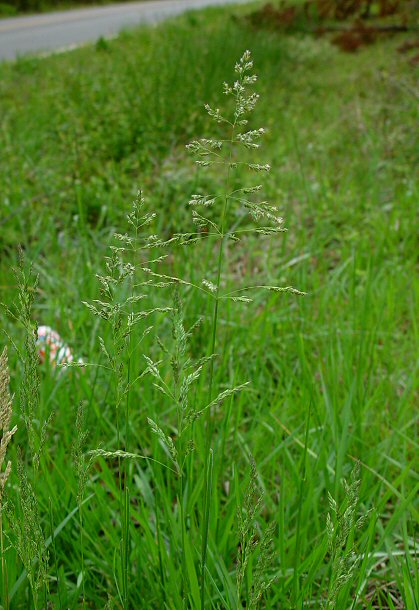Poa pratensis L.
Kentucky Bluegrass

Introduced
CC = *
CW = 3
MOC = 78
© DETenaglia
Poa pratensis L.Kentucky Bluegrass | |
 |
Introduced CC = * CW = 3 MOC = 78 |
© DETenaglia |
|
Family - Poaceae/Poeae Habit - Perennial cool-season (C3) grass, with well-developed rhizomes, forming clumps or loose colonies. Stems - Flowering stems 30-100 cm long, erect, circular in crosssection or very slightly flattened, glabrous.
Leaves - Leaf sheaths rounded or nearly so, glabrous or less commonly somewhat roughened, the ligule 0.7-2.0 mm long, truncate and usually somewhat uneven on the margin. Leaf blades 1-25 cm long, 2-5 mm wide, flat or more commonly folded toward the base, glabrous or roughened along the margins and toward the base.
Inflorescences - Inflorescences 3-15 cm long, usually open, the lowermost whorled nodes with usually 4 or 5 branches, these spreading or ascending at maturity.
Spikelets - Spikelets 3-6 mm long, with 3-5 fertile florets. Lower glume 1.7-3.0 mm long, elliptic-lanceolate, sharply pointed at the tip, with broad, thin margins, 1-nerved, roughened along the midnerve. Upper glume 2.2-3.5 mm long, elliptic-ovate, sharply pointed at the tip, with broad, thin margins, 3-nerved, roughened along the midnerve. Lemmas 2.5-4.0 mm long, elliptic, sharply pointed at the tip, 5-nerved, short-hairy along the keel and the outermost pair of lateral nerves, and with a tuft of long, cobwebby hairs at the base. Anthers 1.0-1.5 mm long.
Fruits - Caryopses 1.5-2.2 mm long, reddish brown, shiny. Flowering - April - July. Habitat - Forests, glades, streambanks, pond margins, roadsides, railroads, pastures, fields, lawns, gardens, open disturbed areas. Origin - Native to Eurasia and possibly also the U.S. Other info. - This common species can be found throughout Missouri and across the continental U.S. This is the most common grass of lawns and golf courses in the midwestern U.S., and thus the most economically important member of the genus. It is also an excellent forage grass for pastures and hayfields, particularly in areas with calcareous substrate. The pollen is a principal cause of hay fever during May and June. Many varieties and cultivars of this grass have been recognized and/or developed. Photographs taken somewhere in North Carolina, 4-27-03 (DETenaglia); also near Labadie, Franklin County, MO, 4-30-2023 (SRTurner). |